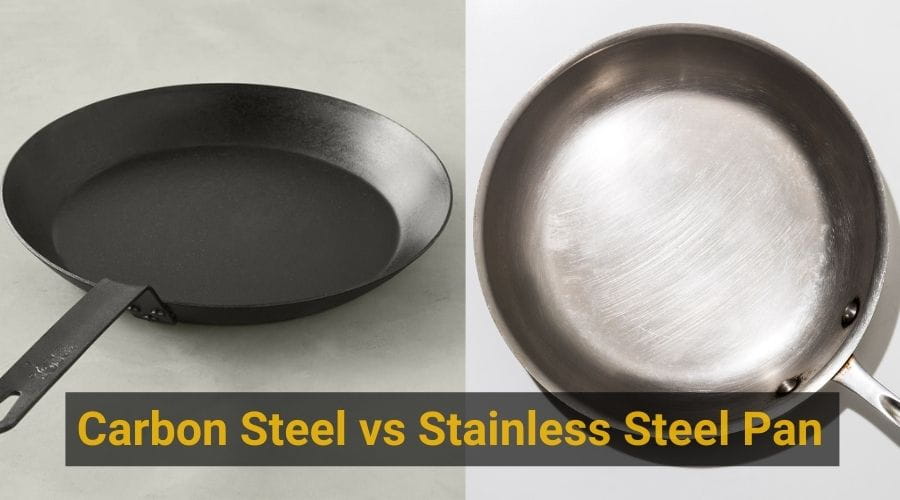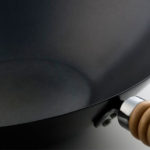Carbon Steel vs Stainless Steel Pan: Which one is Better for You?

When it comes to cooking, there are a variety of materials that pans can be made out of. Two of the most popular materials are carbon steel and stainless steel. But which one is better? You may be thinking about carbon steel vs stainless steel pan which one to opt?
Both materials have their pros and cons, so it can be difficult to decide which one is right for you.
In this blog post, we’ll take a closer look at the differences between carbon steel and stainless steel pans, and we will compare carbon steel and stainless steel pans in terms of durability, heat distribution, price, and more.
So it will become easy for you to decide which material is the best fit for your needs.
Stainless Steel Pan
Stainless steel is a type of steel that contains at least 11% chromium. The chromium forms a protective layer on the surface of the steel, which prevents it from corroding or rusting and make it stainless.
Stainless steel also contains other materials such as nickel and molybdenum. These materials add to the durability of stainless steel and make it more resistant to corrosion.
Stainless steel is a popular material for cookware because it is durable, corrosion-resistant, and heat-resistant. It can withstand high temperatures and it doesn’t react with food, so your food won’t have a metallic taste.
There are different grades of stainless steel, and each grade has a different level of corrosion resistance. The most common grades of stainless steel are 304 and 316.
Stainless steel is often used in kitchen appliances, cookware, knives, and other utensils because it is durable and does not corrode or rust easily. It is also easy to clean and does not stain easily.
Advantages of stainless steel pan
Pros of stainless steel pan
- Stainless steel is a very durable material and it is not susceptible to corrosion or rust.
- It is also a very heat-resistant material, so it can be used on all cooktops, including induction cooktops.
- It doesn’t react with acidic food. When you’re cooking, you don’t want any weird flavors or metallic tastes to change the taste of your food.
- Another big advantage is it is dishwasher safe. Who wants to spend extra time cleaning their pans by hand? Not me.
- Unlike carbon steel pans, you don’t need to season stainless steel pans. This means that you can use them right away, without any extra prep work.
- Stainless steel is a light weight material, which makes it easy to handle.
- Stainless steel is eco friendly, means it doesn’t contain any harmful chemical.
Cons of stainless steel pan
- It is not a good conductor of heat, so it might take longer for your food to cook.
- Stainless steel is not a nonstick, so you may have to use some cooking oil or butter when sautéing foods.
- Stainless steel is often more expensive than carbon steel.
Stainless Steel vs Carbon Steel Pan
Advantages of stainless steel over carbon steel Pan
- There are several advantages that stainless steel has over carbon steel:
- Stainless steel is less reactive with food than carbon steel. This means that your food will not have a metallic taste if it is cooked in stainless steel cookware.
- Stainless steel is more resistant to corrosion than carbon steel.
- Stainless steel is easier to clean than carbon steel because it is less likely to stain.
Disadvantages of stainless steel over carbon steel Pan
- Stainless steel is not as strong as carbon steel pan.
- Stainless steel does not conduct heat as well as carbon steel. This means that food will take longer to cook evenly in stainless steel cookware.
- Stainless steel is more expensive than carbon steel.
Carbon steel Pan
Carbon steel is made by adding small amount of carbon to iron. The amount of carbon added affects the properties of the steel. The more carbon that is added, the harder and stronger the steel becomes. However, too much carbon makes the steel brittle and weak.
It is durable and has excellent heat conductivity. Carbon steel also develops a patina, or natural protective coating, when used over time. This patina helps protect the steel from corrosion.
If you are looking for an inexpensive option for your kitchen, carbon steel is a good choice. It is a popular choice for frying pans and skillets and used for a variety of cooking tasks. However, carbon steel is not as durable as stainless steel and can rust if not properly cared for.
When shopping for a carbon steel pan, make sure to look for one with a heavy bottom. This will help ensure even heat distribution and prevent the pan from scorching your food.
Pros of Carbon Steel Pan
- The first thing you’ll notice about a carbon steel pan is that it’s lightweight. This makes them easy to maneuver, especially when flipping or tossing food during cooking.
- They also have great heat retention, meaning your food will stay warm for longer.
- Carbon steel pans are best for high heat cooking, like searing and stir frying.
- Carbon steel has better heat conduction. This means that heat is distributed more evenly across the surface of the pan, making it less likely to hotspots. As a result, you’ll get more consistent results with your cooking.
- When properly seasoned, carbon steel develops a natural non-stick coating. This makes it easier to cook with and clean. Plus, it’s a healthier option than using synthetic non-stick coatings which can be harmful if they start to chip or flake off.
Cons of Carbon Steel Pan
- Carbon steel pans need to be hand washed with a mild detergent. If they are not cleaned properly, they can rust.
- A carbon steel pan must be seasoned before use. This is a process of coating the cooking surface with oil or fat and heating it until a polymerized film forms. This film helps to protect the pan from rusting and provides a non-stick surface.
- If not properly cared for, a carbon steel pan can rust. Be sure to dry the pan thoroughly after each use and store in a dry place.
- Carbon steel will change in appearance over time. The pan will develop a dark patina from the oils and fats used during cooking.
Carbon Steel vs Stainless Steel Pan
Advantages of carbon steel over stainless steel pan
- Carbon steel pans are also non-stick, seasoning provide a natural barrier between the pan and your food. This makes it a healthier option than stainless steel.
- Carbon steel has the ability to withstand high heats as compared to stainless steel pan.
- One of the big advantage of carbon steel over stainless steel is that carbon steel is less expensive. If you’re looking for an affordable option that will last you years, carbon steel is the way to go.
Disadvantages of carbon steel over stainless steel pan
- Carbon steel is brittle than stainless steel and may need to be treated with a protective coating to prevent rusting.
- Unlike stainless steel, carbon steel doesn’t distribute heat evenly across the pan, which can lead to hotspots and uneven cooking.
- Though carbon steel doesn’t react with acidic foods but its non stick surface may definitely effected by highly acidic foods.
- If not seasoned or used carefully, a carbon steel pan can rust so you’ll need to keep it clean and dry. So in this regard, it needs more maintenance than stainless steel.
Carbon Steel vs Stainless Steel Pan: Which one is better for you?
If you are looking for a durable cookware that will not corrode or rust, stainless steel is a good choice. If you are looking for a material that is less expensive and conducts heat better, carbon steel is the better choice. It all depends on your needs.
If you are looking for a pan that is non-stick and easier to maintain, carbon steel is the better choice. If you are looking for a pan that distributes heat evenly, stainless steel is the better choice.
Related Posts:




